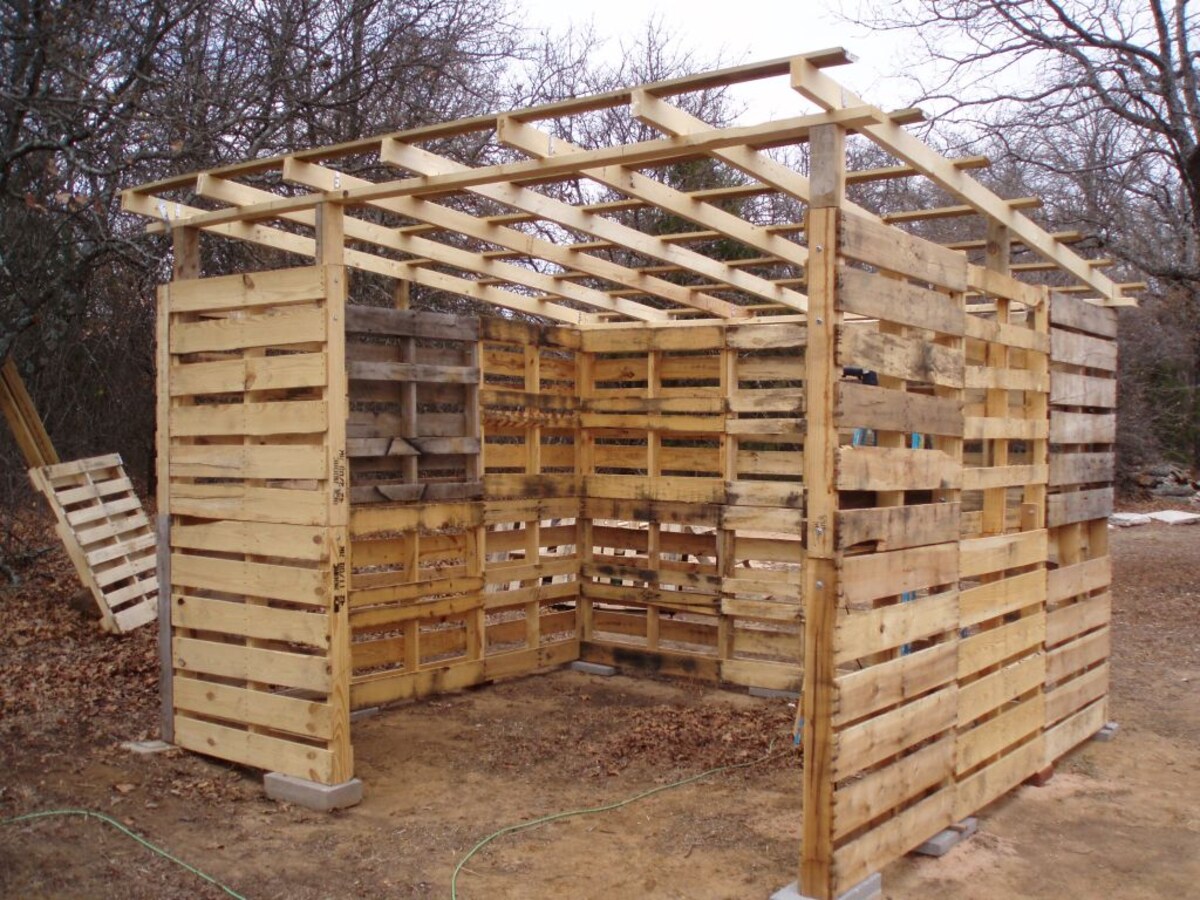Home>Construction & Tools>Building Materials>How Many Bricks Are On A Pallet


Building Materials
How Many Bricks Are On A Pallet
Modified: October 20, 2024
Find out the quantity of building materials you need with our guide on how many bricks are on a pallet. Learn more about palletized bricks today!
(Many of the links in this article redirect to a specific reviewed product. Your purchase of these products through affiliate links helps to generate commission for Storables.com, at no extra cost. Learn more)
Introduction
When embarking on a construction project, whether it’s a small-scale renovation or a large-scale development, the importance of understanding the fundamental aspects of building materials cannot be overstated. Among these materials, bricks stand as a timeless symbol of construction, renowned for their durability, versatility, and aesthetic appeal. However, before delving into the intricacies of bricklaying, it’s essential to comprehend the logistics of their transportation and storage. One common query that arises in this context is, “How many bricks are on a pallet?”
Unraveling the mystery of brick quantities per pallet involves an exploration of standard brick dimensions, pallet specifications, and the various factors that may influence the final count. By gaining insight into these elements, both seasoned professionals and DIY enthusiasts can optimize their planning and procurement processes, ensuring that the right quantity of bricks is readily available for their construction endeavors.
In this comprehensive guide, we will delve into the dimensions of standard bricks and pallets, elucidate the methodology for calculating the number of bricks per pallet, and shed light on the factors that can impact this calculation. Whether you’re a novice seeking foundational knowledge or a seasoned builder aiming to refine your logistical proficiency, this exploration will equip you with the insights needed to navigate the realm of brick quantities with confidence and precision. So, let’s embark on this enlightening journey to demystify the enigmatic question, “How many bricks are on a pallet?”
Key Takeaways:
- Understanding the dimensions of bricks and pallets is crucial for planning construction projects and ensuring the safe and efficient transportation and storage of building materials.
- Calculating the number of bricks per pallet involves considering factors like brick dimensions, pallet size, and load-bearing capacity, enabling construction professionals to optimize logistical processes.
Read more: How Many Square Feet Is A Pallet Of Grass
Standard Brick Dimensions
Bricks, the elemental components of countless architectural marvels, come in various dimensions tailored to diverse construction requirements. The most prevalent among these are the standard modular bricks, which are commonly used in residential and commercial construction projects. These bricks are typically 3 5/8 inches in height, 2 1/4 inches in width, and 7 5/8 inches in length. It’s important to note that while these measurements represent the conventional dimensions, regional variations and specialized brick types may feature slightly different sizing.
Another crucial aspect of standard brick dimensions is their nominal and actual sizes. The nominal size refers to the dimensions of a brick as specified by manufacturers, while the actual size denotes the physical dimensions of the brick once it has been fired and undergone the requisite processes. The difference between nominal and actual sizes is attributed to the shrinkage that occurs during the firing and cooling stages of brick production. Therefore, when calculating the number of bricks per pallet or estimating the quantity required for a project, it’s imperative to consider the actual dimensions of the bricks to ensure precise planning and procurement.
Moreover, beyond the standard modular bricks, there are various other brick types, such as engineer bricks and utility bricks, each with its own distinct dimensions tailored to specific construction purposes. Engineer bricks, for instance, are slightly larger than modular bricks, measuring 3 5/8 inches in height, 2 3/4 inches in width, and 7 5/8 inches in length. Understanding the diverse dimensions of bricks is pivotal in selecting the appropriate type for a given project and accurately gauging the quantity needed for construction and logistical arrangements.
By grasping the nuances of standard brick dimensions and their variations, construction professionals and enthusiasts can make informed decisions when it comes to sourcing, transporting, and utilizing these foundational building blocks. This foundational knowledge forms the cornerstone of efficient construction planning and execution, laying the groundwork for successful and seamless project outcomes.
Pallet Dimensions
As integral components of the logistics and storage infrastructure in the construction industry, pallets play a pivotal role in the transportation and organization of building materials, including bricks. Standard pallets are designed to accommodate a specific quantity of bricks, facilitating efficient handling and storage at construction sites and distribution centers. Understanding the dimensions of these pallets is essential for gauging the quantity of bricks they can hold and optimizing the allocation of space and resources.
The most widely used pallet size for brick transportation and storage is the standard 40” x 48” pallet. This ubiquitous pallet type provides a sturdy and versatile platform for stacking and transporting bricks, aligning with the dimensions commonly utilized in the construction and logistics sectors. The 40” x 48” pallet offers ample surface area to support a substantial quantity of bricks while remaining compatible with forklifts and other handling equipment, streamlining the loading, unloading, and movement of bricks within construction sites and distribution facilities.
Furthermore, pallets are available in various configurations, including two-way entry and four-way entry designs. Two-way entry pallets allow forklifts to access and lift the pallet from two opposite sides, while four-way entry pallets enable lifting from all four sides, enhancing flexibility in handling and maneuvering palletized bricks. This distinction in pallet entry options influences the accessibility and maneuverability of the bricks, impacting the efficiency of loading and unloading operations and the spatial utilization within storage facilities.
Additionally, understanding the load-bearing capacity of pallets is crucial for ensuring the safe and secure storage and transportation of bricks. Pallets are engineered to withstand specific weight limits, and exceeding these limits can compromise the structural integrity of the pallets and pose safety hazards. By adhering to the designated load capacities and distributing the bricks evenly across the pallet surface, construction professionals can mitigate the risk of pallet damage and optimize the utilization of storage space.
By familiarizing oneself with the dimensions and structural considerations of pallets, construction stakeholders can streamline the logistics of brick transportation and storage, fostering efficiency and safety throughout the supply chain. This knowledge empowers professionals to orchestrate seamless material handling processes, enhancing the overall productivity and reliability of construction operations.
A standard pallet of bricks typically contains around 500 bricks, but this can vary depending on the size and type of bricks being used. Always check with the supplier for the exact quantity.
Calculating Bricks per Pallet
Efficiently determining the number of bricks that can be accommodated on a pallet is a critical aspect of construction logistics and inventory management. This calculation involves a systematic approach that considers the dimensions of both the bricks and the pallet, ensuring optimal space utilization and safe load distribution. By mastering the methodology for calculating bricks per pallet, construction professionals can streamline procurement, storage, and transportation processes, bolstering the efficiency and cost-effectiveness of their projects.
The first step in calculating the number of bricks per pallet is to ascertain the surface area of a single brick. This is achieved by multiplying the length and width of the brick, yielding the total square inches of the brick’s face. Subsequently, the total surface area of the pallet is determined by multiplying its length and width, providing the overall square inches available for stacking bricks.
Once the surface area of a single brick and the total surface area of the pallet are established, the next consideration is the stacking pattern and spacing between the bricks. By factoring in the necessary gaps to maintain stability and facilitate handling, the effective surface area for brick placement is refined, enabling a realistic estimation of the brick count per layer on the pallet.
Furthermore, accounting for the height of the brick layers is essential in calculating the total number of bricks per pallet. By dividing the vertical space available on the pallet by the height of a single brick, the maximum number of layers that can be stacked is determined, culminating in the final count of bricks per pallet.
It’s important to note that while these calculations provide a theoretical estimate of the brick quantity per pallet, practical considerations such as weight distribution, load stability, and handling feasibility should also be taken into account. Ensuring that the pallet load adheres to safety regulations and operational requirements is paramount, warranting a balance between maximizing brick quantity and maintaining the integrity and manageability of the palletized load.
By mastering the intricacies of calculating bricks per pallet, construction professionals can optimize their procurement and storage strategies, harmonizing logistical efficiency with safety and practicality. This proficiency empowers stakeholders to orchestrate seamless material handling processes, bolstering the operational prowess and cost-effectiveness of construction endeavors.
Factors Affecting Brick Count
While the calculation of bricks per pallet provides a fundamental framework for logistical planning, several factors can influence the actual quantity of bricks that can be accommodated on a pallet. Understanding these variables is crucial for refining the accuracy of brick count estimations and optimizing the utilization of storage and transportation resources in construction projects.
One of the primary factors impacting brick count is the variation in brick dimensions. Although standard brick dimensions serve as a foundational reference, deviations in length, width, or height among individual bricks can affect the stacking configuration and the overall quantity that can be accommodated on a pallet. Ensuring uniformity in brick dimensions and accounting for any disparities during the stacking process is essential for maximizing pallet capacity.
Moreover, the presence of spacers or mortar between the bricks can influence the effective space utilization on a pallet. The inclusion of spacers for stability and alignment, as well as the allocation of space for mortar joints, necessitates adjustments in the stacking pattern and spacing between the bricks, potentially impacting the final brick count per pallet. By factoring in these elements, construction professionals can refine their estimations to align with the practical realities of brick storage and transportation.
Another critical consideration is the weight and load-bearing capacity of the pallet. Bricks are substantial building materials, and the cumulative weight of a palletized brick load can exert significant pressure on the pallet structure. Understanding the load-bearing limits of the pallet and accounting for the weight distribution across the pallet surface is essential for ensuring the stability and integrity of the stacked bricks, as well as the safety of handling and transportation operations.
Furthermore, the stacking pattern and orientation of the bricks on the pallet can impact the overall brick count. Varied stacking configurations, such as interlocking patterns or specific orientations to optimize stability and load distribution, can influence the spatial efficiency and the total quantity of bricks that can be accommodated within the confines of a pallet.
By acknowledging and addressing these factors, construction professionals can refine their approach to calculating and optimizing the brick count per pallet, fostering precision and practicality in their logistical planning. This comprehensive understanding of the nuanced variables at play empowers stakeholders to orchestrate efficient and resource-conscious material handling processes, enhancing the operational proficiency and cost-effectiveness of construction endeavors.
Conclusion
As the cornerstone of countless architectural feats, bricks hold a revered status in the realm of construction, embodying durability, versatility, and timeless appeal. The logistical intricacies surrounding the quantity of bricks on a pallet underscore the significance of understanding standard brick dimensions, pallet specifications, and the multifaceted factors that influence brick count estimations. By unraveling these complexities, construction professionals and enthusiasts can navigate the realm of brick quantities with precision and foresight, optimizing their procurement, storage, and transportation processes.
The exploration of standard brick dimensions revealed the nuanced variations in size and the importance of considering both nominal and actual dimensions when gauging brick quantities. This foundational knowledge empowers stakeholders to make informed decisions in selecting the appropriate brick types and accurately estimating the quantity required for construction projects.
Delving into pallet dimensions shed light on the pivotal role of pallets in the transportation and storage of bricks, emphasizing the significance of understanding pallet sizes, entry configurations, and load-bearing capacities. This comprehension equips construction professionals with the insights needed to orchestrate efficient and safe material handling processes, optimizing the utilization of storage space and streamlining logistical operations.
The methodology for calculating bricks per pallet provided a systematic framework for estimating the quantity of bricks that can be accommodated on a pallet, emphasizing the importance of surface area considerations, stacking patterns, and practical feasibility. This proficiency in calculation enables stakeholders to harmonize logistical efficiency with safety and practicality, fostering seamless material handling processes.
Furthermore, the exploration of factors affecting brick count underscored the nuanced variables that can influence the actual quantity of bricks on a pallet, highlighting the importance of accounting for variations in brick dimensions, the presence of spacers and mortar, pallet load-bearing capacities, and stacking configurations. This comprehensive understanding empowers construction professionals to refine their estimations and optimize the utilization of storage and transportation resources with precision and foresight.
In essence, the demystification of the enigmatic question, “How many bricks are on a pallet?” equips construction stakeholders with the knowledge and proficiency needed to navigate the logistical intricacies of brick quantities with confidence and precision. By leveraging this comprehensive understanding, professionals can orchestrate efficient, cost-effective, and safe material handling processes, underpinning the success and reliability of construction endeavors.
Frequently Asked Questions about How Many Bricks Are On A Pallet
Was this page helpful?
At Storables.com, we guarantee accurate and reliable information. Our content, validated by Expert Board Contributors, is crafted following stringent Editorial Policies. We're committed to providing you with well-researched, expert-backed insights for all your informational needs.















0 thoughts on “How Many Bricks Are On A Pallet”